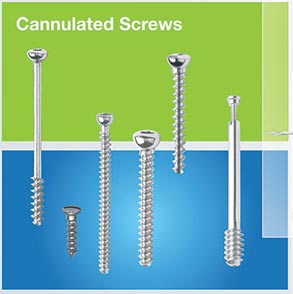Cannulated screws are hollow screws that have a hollow central sha ft. It is to be noted that cortical and cancellous screws both can be cannulated. In orthopedic surgery, the use of cannulated cancellous screws is generally for metaphyseal fractures. The surgeons use cannulated and noncannulated cortical screws for fixation of diaphyseal fractures. In that case, these screws are used as lag screws. Cannulated screws exporter company in India such as HEMC Ortho make sure that all global quality standards are ardently followed in making these orthopedic instruments.
ft. It is to be noted that cortical and cancellous screws both can be cannulated. In orthopedic surgery, the use of cannulated cancellous screws is generally for metaphyseal fractures. The surgeons use cannulated and noncannulated cortical screws for fixation of diaphyseal fractures. In that case, these screws are used as lag screws. Cannulated screws exporter company in India such as HEMC Ortho make sure that all global quality standards are ardently followed in making these orthopedic instruments.
Use of cannulated screws
One of the main advantages of using cannulated screws is that the surgeons can insert them over a guide wire. The surgeons can also use these screws over a guide pin. Another advantage of these screws is that its diameter is much bigger than the diameter of the guide pin. Hence, guide pin can be placed using fluoroscopy. Moreover, due to its small diameter, the guide pin is useful in reinserted many times without excessive damage to bone. The Knowles pin is a type of cannulated screw. The Knowles pin is used for fixing of slipped capital femoral epiphysis in children.
Cannulated screws mainly come in 6.5 mm and 7.3 mm. These sizes of screw can accommodate an array of fracture patterns as well as different patient anatomy. These screws are either partially or fully threaded. The surgeons can insert cannulated screws and instruments in a minimal invasion way.
When it comes to using partially threaded screws, surgeons use to lag one bone fragment to another. In this case, the threads of the screw capture the bone fragment and pull it toward the cortex fragment, which is to the head side of the screw. On the other hand, surgeons use fully threaded screws to stabilize fractures so that there is no or only a little compression across the fracture.
HEMC Ortho ensure that these screws are in line with the requirements of the orthopedic surgery. Every minute detail in designing and manufacturing of the screws is considered and followed.
The cannulated screw system
The cannulated screw system is generally used in some specific parts of body. These parts are mostly the hip, pelvis, knee, ankle, and foot. Surgeons chose the 6.5 mm screws on a range of bone fractures. The application of this size of screws is mostly on femoral inercondylar fractures and tibial plateau, subtalar arthrodesis, ankle arthrodesis, and triple arthrodesis. The 7.3 mm screws are generally used on the fractural injuries on femoral neck and head fracture, sacroiliac joint disruption, acetabular fracture, and calcaneal fracture.
Surgeons use the Acumed Cannulated Screw System also. This screw system is mainly used for fixation of fractures. The system is also in use generally for fusions, and osteotomies of small and large bones that are appropriate for the size of the device. These screws are available in 6.7 mm and 7.3 mm diameters. The length of the screws ranges from 30 mm to 150 mm. The function of these screws is to accommodate different fracture patterns and patient anatomy. Note that all such screws are cannulated for using them over a guide wire. Each screw is fully or partially threaded by use of a cancellous thread form.


Leave A Comment